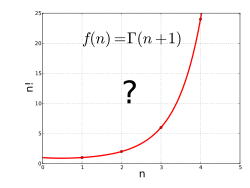
The gamma function along part of the real axis
In
mathematics, the
gamma function (represented by the capital
Greek alphabet letter
Γ) is an extension of the
factorial function, with its
argument shifted down by 1, to
real and
complex numbers. That is, if
n is a
positive integer:

The gamma function is defined for all complex numbers except the non-positive integers. For complex numbers with a positive real part, it is defined via a convergent
improper integral:

This integral function is extended by
analytic continuation to all complex numbers except the non-positive integers (where the function has simple poles), yielding the
meromorphic function we call the gamma function. In fact the gamma function corresponds to the
Mellin transform of the negative
exponential function:

The gamma function is a component in various probability-distribution functions, and as such it is applicable in the fields of
probability and
statistics, as well as
combinatorics.
Motivation[edit]

It is easy graphically to interpolate the factorial function to non-integer values, but is there a formula that describes the resulting curve?
The gamma function can be seen as a solution to the following
interpolation problem:
- "Find a smooth curve that connects the points (x, y) given by y = (x − 1)! at the positive integer values for x."
A plot of the first few factorials makes clear that such a curve can be drawn, but it would be preferable to have a formula that precisely describes the curve, in which the number of operations does not depend on the size of
x. The simple formula for the factorial,
x! = 1 × 2 × … × x, cannot be used directly for fractional values of
x since it is only valid when
x is a
natural number (
i.e., a positive integer). There are, relatively speaking, no such simple solutions for factorials; no finite combination of sums, products, powers,
exponential functions, or
logarithms will suffice to express
x!; but it is possible to find a general formula for factorials using tools such as
integrals and
limits from
calculus. A good solution to this is the gamma function.
[1]
There are infinitely many continuous extensions of the factorial to non-integers: infinitely many curves can be drawn through any set of isolated points. The gamma function is the most useful solution in practice, being
analytic (except at the non-positive integers), and it can be characterized in several ways. However, it is not the only analytic function which extends the factorial, as adding to it any analytic function which is zero on the positive integers, such as
k sin nπ, will give another function with that property.
[1]
A more restrictive property than satisfying the above interpolation is to satisfy the
recurrence relation defining a translated version of the factorial function,

for
x equal to any positive real number. The
Bohr–Mollerup theorem proves that these properties, together with the assumption that
f be
logarithmically convex (or "super-convex"
[2]), uniquely determine
f for positive, real inputs. From there, the gamma function can be extended to all real and complex values (except the negative integers and zero) by using the unique
analytic continuation of
f.
[3] Also see Euler's infinite product definition below where the properties
f(1) = 1 and
f(x+1) = x f(x) together with the asymptotic requirement that
limn→+∞ (n−1)! nx / f(n+x) = 1 uniquely define the same function.
Definition[edit]
Main definition[edit]
The notation
Γ(z) is due to
Legendre.
[1] If the real part of the complex number
z is positive (
Re(z) > 0), then the
integral

converges absolutely, and is known as the
Euler integral of the second kind (the Euler integral of the first kind defines the
beta function).
[1] Using
integration by parts, one sees that:

![{\displaystyle =\left[-x^{z}e^{-x}\right]_{0}^{\infty }+\int _{0}^{\infty }zx^{z-1}e^{-x}\,\mathrm {d} x}](https://wikimedia.org/api/rest_v1/media/math/render/svg/0251ec35329700f988895d89abe2a2ad71055d1d)

- Recognizing that as


We can calculate

:
![{\displaystyle \Gamma (1)=\int _{0}^{\infty }x^{1-1}e^{-x}\,\mathrm {d} x=\left[-e^{-x}\right]_{0}^{\infty }}](https://wikimedia.org/api/rest_v1/media/math/render/svg/6624f8395e3cb0cc494a810f60354c80af68bce8)

Given that

and


for all positive integers

.
The identity

can be used (or, yielding the same result,
analytic continuation can be used) to uniquely extend the integral formulation for

to a
meromorphic function defined for all complex numbers

, except integers less than or equal to zero.
[1]
It is this extended version that is commonly referred to as the gamma function.
[1]







![{\displaystyle =\left[-x^{z}e^{-x}\right]_{0}^{\infty }+\int _{0}^{\infty }zx^{z-1}e^{-x}\,\mathrm {d} x}](https://wikimedia.org/api/rest_v1/media/math/render/svg/0251ec35329700f988895d89abe2a2ad71055d1d)




![{\displaystyle \Gamma (1)=\int _{0}^{\infty }x^{1-1}e^{-x}\,\mathrm {d} x=\left[-e^{-x}\right]_{0}^{\infty }}](https://wikimedia.org/api/rest_v1/media/math/render/svg/6624f8395e3cb0cc494a810f60354c80af68bce8)








No comments:
Post a Comment